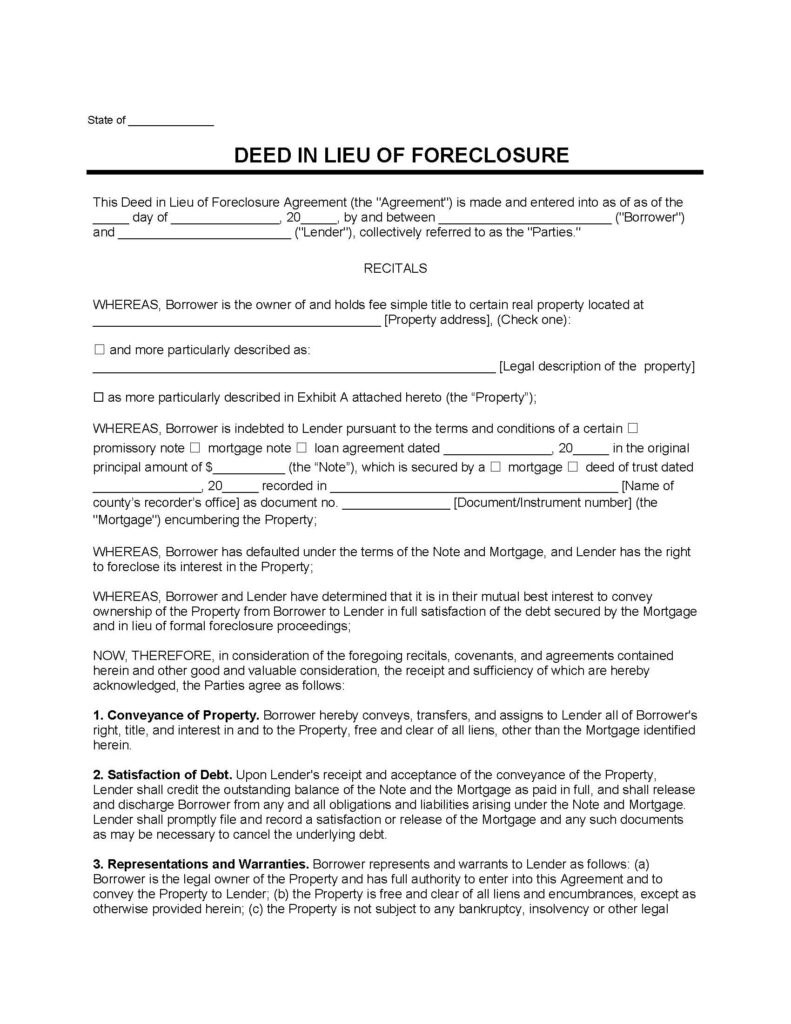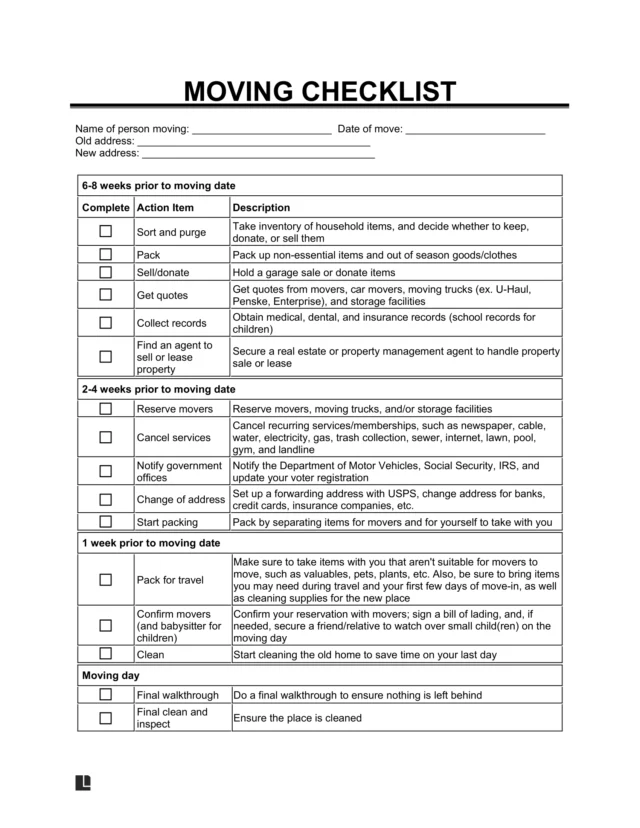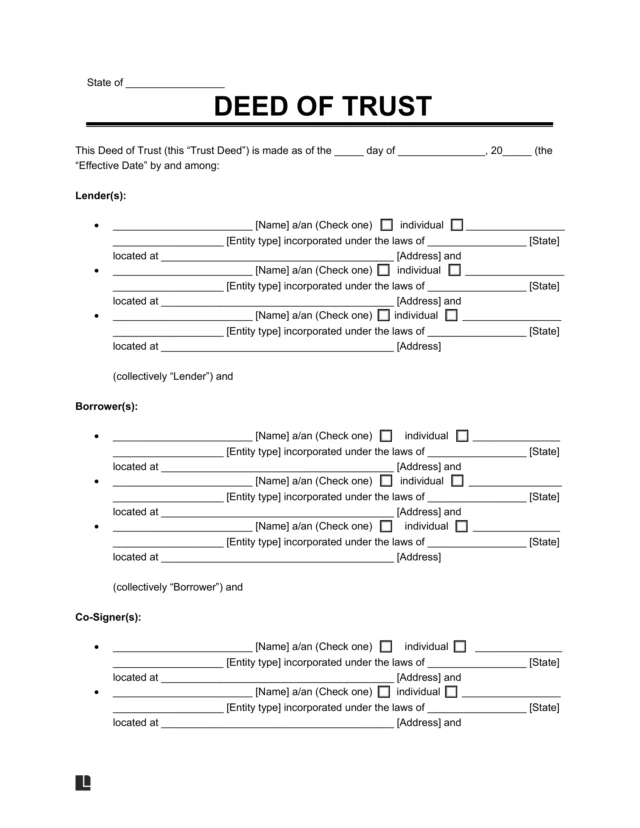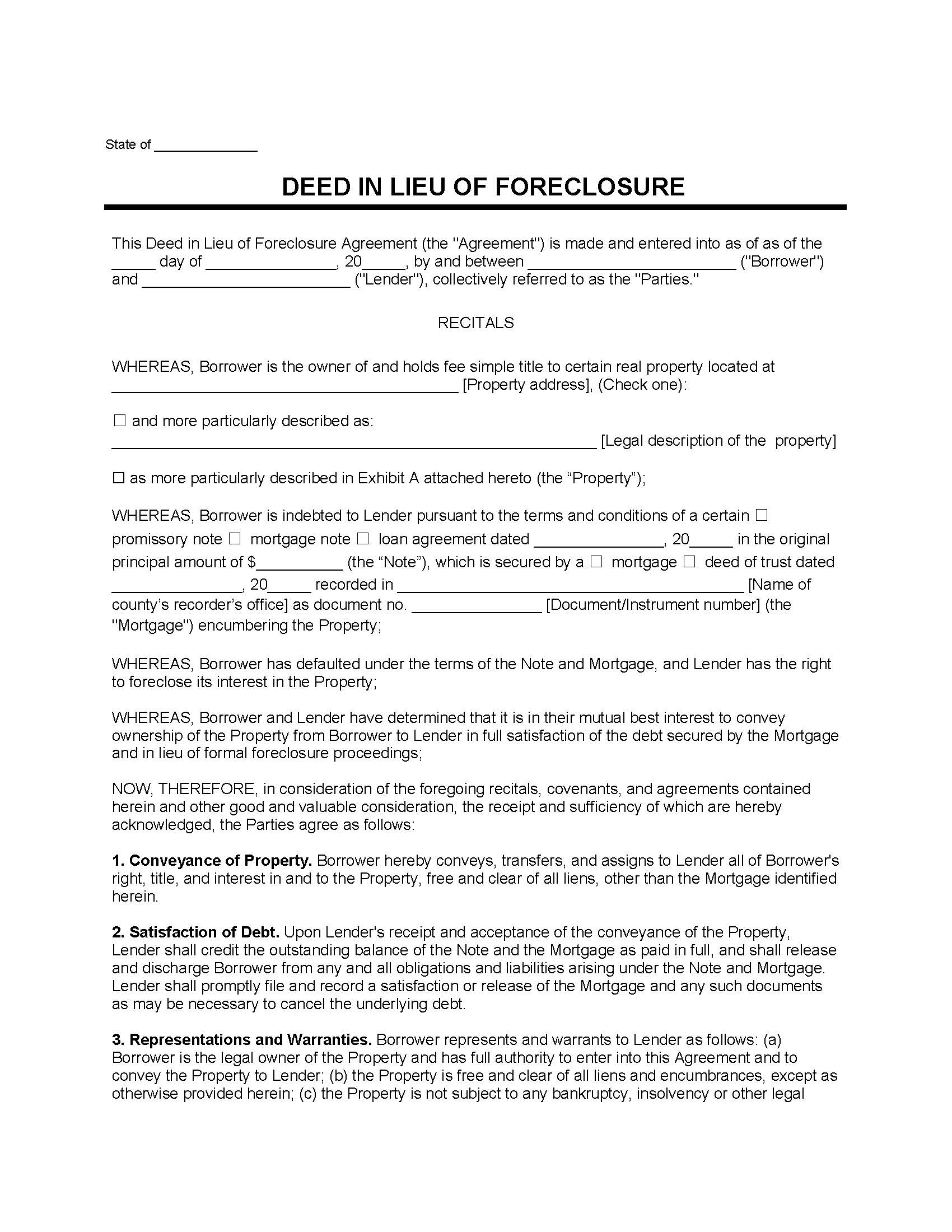A Deed in Lieu of Foreclosure benefits a mortgage borrower because he or she can avoid foreclosure by voluntarily turning the property over to the lender. The lender benefits from the ability to sell or lease the property relatively quickly instead of going through a lengthy court process.
What Is a Deed in Lieu of Foreclosure?
A deed in lieu of foreclosure is a contract between a lender and a borrower where the borrower transfers property to the lender. In turn, the lender waives the borrower’s mortgage debt and does not pursue foreclosure.
Borrowers who are no longer able to make payments on a mortgage may be able to avoid foreclosure by transferring the property to the lender with a deed in lieu of foreclosure.
In exchange for the borrower’s property, the lender waives all the borrower’s mortgage debts. The agreement should be in writing and signed by all parties involved before the conveyance of property and debt cancellation can begin.
Deed in Lieu vs. Foreclosure
A deed in lieu and a foreclosure are contracts with entirely different purposes. Below are some of the features of each.
Deed in Lieu
A deed in lieu is an agreement between a borrower and lender to avoid foreclosure proceedings. It helps minimize the damage to a borrower’s credit rating when they can’t make monthly home payments.
Foreclosure
A formal foreclosure happens when a lender takes possession of a mortgaged property involuntarily. This occurs when the borrower falls behind on payments for an extended period. A foreclosure typically hurts a credit score for years.
Why a Lender May Reject a Deed in Lieu of Foreclosure
- Reasons your lender may reject a request for a deed in lieu of foreclosure include:
- They may not know how to process a deed in lieu of foreclosure
- The loan you initially took out is backed by a government guarantee (in this case, a lender may require you to foreclose on your property instead)
- A lender may look at your property’s condition and value and choose to decline
Why a Lender Might Accept a Deed in Lieu of Foreclosure
A lender doesn’t have to accept your request for a deed in lieu, but one has an incentive to.
Some benefits for lenders include the following:
- Quicker control over a property with payment in arrears. Lenders don’t have to go to court to take your property with a deed in lieu.
- Better condition of the property. Many lenders receive properties with minimal damage when they agree to a deed in lieu, and some will even make property upkeep of the home a condition of the contract.
Understanding Deed in Lieu of Foreclosure
There are scenarios when you should and shouldn’t use a deed in lieu of foreclosure and several considerations when agreeing to this situation.
Ensure you understand all details of this contract before signing one.
When Would a Deed in Lieu of Foreclosure Be Used?
If you, as a borrower, contend with a looming foreclosure, you can work with your lender to use a deed. This kind of agreement allows you to escape the long-term effects of an unmitigated foreclosure.
That said, beware of consequences, like a reduction in your credit score and property loss.
It’s often recommended that you pursue a modification to your loan agreement or a short sale before seeking out a deed in lieu of foreclosure, as that document sees you lose the property you’ve been working to pay off.
How Does a Deed in Lieu of Foreclosure Work?
You need to demonstrate financial hardship or an inability to pay your mortgage if you want to utilize a deed in lieu of foreclosure. You can collaborate with your local bank or financial planner to compare your income against your expenses.
Once you have evidence of financial hardship on hand, present that evidence to your lender and ask about your right to a deed in lieu of foreclosure. Some lenders don’t make this option available to their borrowers.
If you get the go-ahead, you can legally sign the title to your property over to the lender. Once you’ve signed the deed, the lender will issue you a mortgage release. That mortgage release then represents your satisfaction of mortgage debts.
How to Use a Deed in Lieu of Foreclosure
A borrower isn’t the only party who can begin a conversation about a deed in lieu of foreclosure. If a lender wants to reclaim property or is otherwise sympathetic to the borrower’s plight, the lender may initiate these conversations.
When the two parties agree, the borrower presents to the lender an application for a deed in lieu of foreclosure along with evidence elaborating on their financial hardships.
The borrower needs to clarify in their paperwork that they are voluntarily entering into a deed in lieu of a foreclosure agreement, or else the contract may be void.
The borrower then waits for the lender to approve or deny their request for a deed in lieu of foreclosure.
If approved, the lender composes a letter outlining the nature of their agreement with the borrower. At this point, property transfer and debt cancellation can proceed.
Pros and Cons of a Deed in Lieu of Foreclosure
Lenders and borrowers alike have complicated relationships with deeds in lieu of foreclosure. There are pros and cons to the use of this document for both parties.
Lenders: Pros and Cons
Lenders who accept a deed in lieu of foreclosure benefit from reclaiming a property they can sell to a different buyer. A deed in lieu of foreclosure also helps lenders avoid the repossession costs of a traditional foreclosure.
That said, lenders take on a significant financial burden when accepting a deed in lieu of foreclosure. This is particularly true if a borrower has junior (second mortgage) liens tied to the property. If the lender can’t sell the property in a reasonable amount of time, there may be more financial downsides to the deed in lieu of foreclosure than upsides.
Borrowers: Pros and Cons
The benefits of a deed in lieu of foreclosure lean heavily in the borrower’s favor. Borrowers can use deeds in lieu of foreclosure to overcome substantial mortgage debt.
What’s more, these deeds allow borrowers to avoid the foreclosure process, thus protecting their credit score and their time.
On the other hand, borrowers face severe losses as they transfer the property they’ve worked hard to develop over the years. The borrower’s credit score will still be negatively affected, although not as drastically as with foreclosure.
There’s also no way to guarantee that a lender will accept a deed in lieu of foreclosure.
Tip: if your credit score is already in trouble, consider pursuing a short sale or a modification to your lending agreement before requesting a deed instead of foreclosure.
What to Include in a Deed in Lieu of Foreclosure
When drafting a deed in lieu of a foreclosure agreement, the parties need to include information regarding the original mortgage and that the borrower will convey their property to the lender in satisfaction of the mortgage debt and in lieu of foreclosure.
Borrowers may need to include documents to support financial hardship, such as monthly budget and expenses, bank statements, tax returns, and proof of income or lack thereof.
Lenders may also request borrowers submit hardship affidavits alongside primary evidence of a financial struggle.
Tip: your hardship affidavit can detail your recent loss of income, increase in housing expenses, or a reduction in assets when highlighting your financial difficulties.
How to Write a Deed in Lieu of Foreclosure
A deed in lieu of foreclosure agreement is straightforward to draft.
The information needed includes:
- The names of the borrower and lender
- The address and legal description of the property
- The details of the original mortgage, including the amount, date, and where the mortgage is recorded
- The closing date on which the borrower’s property is conveyed to the lender
The lender and borrower must sign the deed in lieu of foreclosure document to finalize it. Consider having witnesses or notary acknowledgment to add validity to the signatures.
Sample

Frequently Asked Questions
What are the tax consequences of a deed in lieu of foreclosure?
While a deed in lieu of foreclosure does free you of your mortgage debts, those savings can count as income. The IRS specifically considers forgiven debts, like those you’d benefit from upon filing a deed in lieu of foreclosure, as income.
Borrowers can expect to pay taxes on that forgiven debt when the upcoming tax season rolls around.
Does a deed in lieu of foreclosure affect credit?
Filing a deed in lieu of foreclosure does hurt your credit score. However, the effect of a deed in lieu of foreclosure on your credit is nowhere near as severe as the effect of a foreclosure.
Does a deed in lieu of foreclosure wipe out junior liens?
When a borrower and lender complete a deed in lieu of foreclosure, the lender can issue the borrower a mortgage deed release. A mortgage deed release wipes out the original mortgage and any junior (second) mortgages on the property.
Is a deed in lieu of foreclosure the same as a short sale?
A deed in lieu of foreclosure differs from a short sale. A short sale is another tool that borrowers can use to avoid foreclosure.
With a short sale, you sell your home for far less than its market value. In turn, a lender can relieve you of your mortgage debt.
You are, however, still expected to inform your lender of your financial hardship and obtain prior approval from the lender before proceeding with a short sale.
Can a deed in lieu of foreclosure be reversed?
When you file a deed instead of foreclosure, you forgo your property ownership.
It is not possible to reverse a deed in lieu of foreclosure. That’s why it’s in a borrower’s best interest to explore other relief options before considering a deed in lieu of foreclosure.




